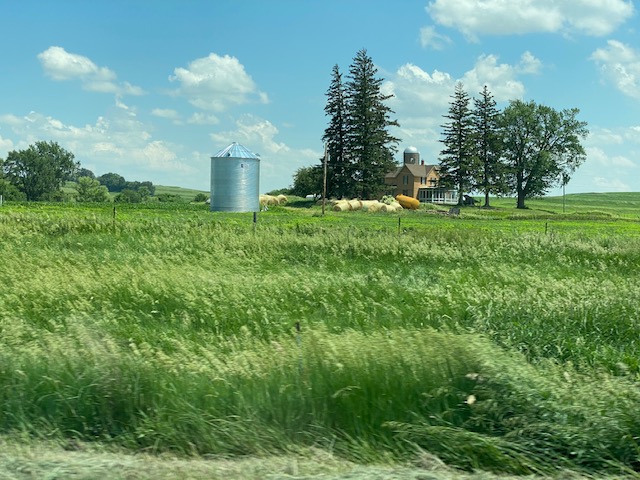
Back in the Heartland
Here we are once again, back in Ames, Iowa — the great Heart of the American Heartland. Ames is the home of Iowa State University, but this fine old town also boasts a fine old-fashioned downtown Main Street, majestic churches and many historic homes, some dating back to the 1860’s. Yes, we’re finally here, after a daunting four-day “try to avoid the coronavirus” trek that spanned 1,800 miles and seven states. This was the third year in a row we’ve come to Ames, and this trip was our most stressful, by far. For starters, we had to plan our route, then plan again, and finally start all over again, until the day we left Paso Robles.
This was the third year in a row we’ve come to Ames, and this trip was our most stressful, by far. For starters, we had to plan our route, then plan again, and finally start all over again, until the day we left Paso Robles.
Our goal was to try to stay in places that had little or no coronavirus activity. It was harder than you might think. We had to avoid staying in major cities because they’ve been infested, big-time. So our ultimate “road map” took us past those big cities and into much smaller ones, starting with Cedar City, Utah, this past Sunday.
It took us nearly 10 hours to get there. We left Paso around 9 a.m. and stopped two hours later to try to buy gas in Bakersfield — gas that would have cost $2.69 a gallon — much cheaper than in Paso.
But no luck, because that particular gas station’s pumps could not read my credit card. So it was back on the road again, this time to Tehachapi, where we filled up at a nice-looking Love’s Rest Stop.
The gas was $2.49 a gallon. The bathrooms were clean. Lots of people were inside the food mart there, and some even wore masks.
Sharon had made sandwiches before we left so that we would not have to stop for lunch at any restaurants. Instead, we parked at a rest stop on Interstate 15, north of Barstow. It was not very crowded, and we were happy to see that.
After lunch, we continued heading north on the 15, passing mostly desert but also the somewhat-famous Mad Greek Café in Baker. The Mad Greek, unfortunately for its clients, had not found a way to re-open after coronavirus-mandated closures were lifted for the state’s restaurants.
A few miles later –and about 40 miles south of Las Vegas — we encountered our first astonishing sight. In retrospect, it should not have surprised us, but we figured that people would still be showing some semblance of restraint, even though Vegas casinos had recently re-opened. I mean, is it really worthwhile to risk your health to gamble?
The answer — emphatically — is yes — proven by the amazing traffic jam we saw in the southbound lanes of the 15. Thousands and thousands of cars were crawling along at perhaps 25 miles an hour — when they weren’t completely stopped — in all three lanes of that interstate. It was traffic from Vegas, where Southern Californians had flocked to spend the weekend — coronavirus be damned.
That traffic jam lasted until we reached the Vegas city limits. In our northbound lanes, we were cruising at 70 as we drove through the heart of Sin City. I was surprised to see that the soon-to-be home of the Las Vegas (formerly Oakland) Raiders is directly across the interstate from all the gambling high-rises. I’m sure the NFL isn’t worrying about that potentially ominous symbolism, so I won’t, either.
We drove on and on that Sunday, seeing some absolutely gorgeous scenes — including incredible rock formations — after we had driven through a small slice of Arizona and made our way into Utah. We stopped again for gas in St. George, Utah, where we paid $2.23 a gallon. You get the idea? Yes, gasoline got cheaper and cheaper, the farther we drove away from California.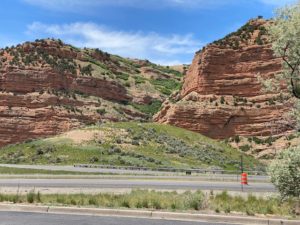 We overnighted in a delightful LaQuinta Inn in Cedar City — about an hour north of St. George. The clerk told us the hotel was half-full — and that, because of local restrictions, we would not be able to get breakfast there the next morning. Darn! We stay at LaQuintas partly because of those usually plentiful buffets.
We overnighted in a delightful LaQuinta Inn in Cedar City — about an hour north of St. George. The clerk told us the hotel was half-full — and that, because of local restrictions, we would not be able to get breakfast there the next morning. Darn! We stay at LaQuintas partly because of those usually plentiful buffets.
So Monday morning saw us at a McDonalds drive- through. Hey, don’t laugh — it cost less than $6 to get their “Big Breakfast,” and it’s not only big, but surprisingly tasty, as well. Sharon had brought fruits and nuts along on the trip, and she made do with them, not wanting any food from drive-throughs. Always eating healthy.
Day Two of our trek saw us head into the first of the 80 mph speed “limits” we’d encounter. We kept it at 75, and every now and again someone would zoom past as if we were doing 45. Along the way — still in Utah — we stopped at a “Maverik” (yes, that’s the way they spell it) station. Gas was $2.22, and the restrooms were clean. What more can you ask?
Well, there was one thing more we could have asked, but we knew the answer. Not one of the other customers inside or outside the station and store was wearing a mask. They were so “done” with the coronavirus — and too clueless to know the coronavirus is not “done” with them.
Finally, after 800 miles, we reached Interstate 80 in Utah. Only 1,000 miles to go — virtually all of it on that straight line that is the 80. After another nice “made by Sharon” lunch at a rest stop near the Utah-Wyoming border, we drove into Rawlins, Wyoming, for an overnight stay.
Trust me. We won’t go back. First, Rawlins was not pretty — and that’s putting it nicely. And more importantly, there was no LaQuinta — only a Microtel that looked dismal, not to mention dirty. We sanitized our little room — figuring someone had to — and slept uneasily until dawn, when we got up and quickly made our way to another McDonald’s drive-through (no meal was available at the Microtel, and truth to tell, we likely would not have eaten it if it had been).
Another Big Breakfast for me — more fruits and nuts for Sharon — and we were back on the 80, again. Wyoming’s countryside is nothing to write home about — at least, it wasn’t for us — but it did have some interesting man-made features. Snow fences. Many of them. All designed to keep the white stuff from drifting into parts of the grazing land we were quickly passing.
Not soon enough, we made our way into Nebraska, where we passed one gas station that was selling at $1.82. After another long day of about 500 miles, we were getting truly weary, and needed a good night’s rest in a good motel.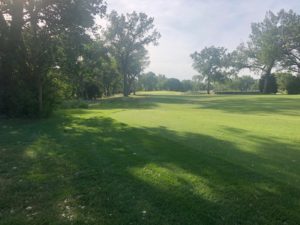
And we got it. We had stayed at the LaQuinta in North Platte, Nebraska, before, and we had good memories of that visit. This LaQuinta is right across the street from the Iron Eagle Golf Course. So it was a win-win situation — we had a good-looking room in a quite-clean motel, and I got to walk several of the holes on this lovely golf course before the sun went down. I did not have to rush — sunset in North Platte was around 9:20.
While we were at that LaQuinta, we watched the local newscasts, as we do in every city or town where we stay. Yes, old habits — and careers — die hard. Anyway, at one of the local outlets, the weatherman looked — well, weathered. This is not to say he looked bad — in fact, he appeared to be just fine. A bit of research identified him as Ken Siemek, and revealed that he had been the weather guy at that station for 40 years. I like that. A lot. Finally, it was Day Four — the last one — of our road trip. It started wonderfully, with nice grab-and-go breakfast bags filled with yogurt and granola bars and muffins and orange juice — along with a real orange — all courtesy of our LaQuinta. Then we headed east once again, passing through several Nebraska towns — some of which looked quite nice. I’m talking about you, Lincoln and Omaha. Then, the Missouri River — and Iowa!
Finally, it was Day Four — the last one — of our road trip. It started wonderfully, with nice grab-and-go breakfast bags filled with yogurt and granola bars and muffins and orange juice — along with a real orange — all courtesy of our LaQuinta. Then we headed east once again, passing through several Nebraska towns — some of which looked quite nice. I’m talking about you, Lincoln and Omaha. Then, the Missouri River — and Iowa!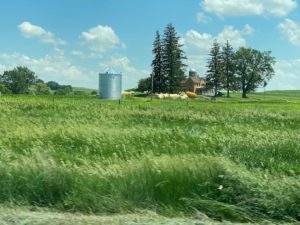
We ate our last Sharon-made lunch at a heavily-wooded and delightful rest stop at the Iowa Welcome Center. Then we drove those final miles past Iowa’s green and rolling hills, complete with picturesque calendar-worthy scenes — and made our way into Ames around 5 p.m. on Wednesday.
And when we opened the door to our condo — after being gone for eight months — it was as if we had never left. Everything looked the same — everything felt great — and there we were, at “home” (our second) again.
But we could not rest — not quite yet. We had to go grocery shopping — in this case, at the new Fareway that had been completed in downtown Ames while we were gone. The new, bigger one — built right beside the old one, which had been torn down — was a delight. Wide aisles. Great lighting. Plenty of produce and meat. And even signs on the floor, reminding those who might not remember — or want to — that we are still in a pandemic.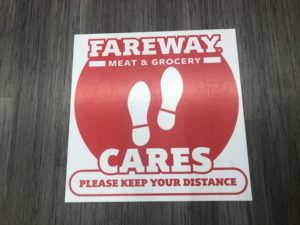 And perhaps most delightful of all — virtually every customer — and all Fareway employees — were wearing masks, as we were.
And perhaps most delightful of all — virtually every customer — and all Fareway employees — were wearing masks, as we were.
So now our annual summer adventure in Ames starts — with significant differences. Virtually every outdoor activity we’ve partaken of in recent visits is shut down this summer. No municipal band concerts. No Fourth of July free breakfasts outside City Hall. No Fourth parade or fireworks.
And Ames is now experiencing a coronavirus surge because of the return of football players to the Iowa State campus. Yes, those players are doing what young athletes do — and it does not involve social-distancing or restraint. The result — a big uptick in virus cases.
Fortunately, we live in Old Town — east of campus and far from Campustown. Young people rarely venture out our way — it’s far too boring for them. For us, of course, it’s delightful — which is why we came back here again, in this Summer of Our Discontent.
After all, Paso Robles — and all of California — are experiencing coronavirus surges — so why not make the trek to Iowa, another place we truly love?
But our stay here will be much shorter than usual. We’ll depart no later than mid-August — which is when the “rest” of the Iowa State students — some 30,000 of them — will come back to town, bringing with them quite a load of coronavirus, we believe.
Before then, we plan to live as carefree — and carefully — as we can. This weekend, we want to get some take-out barbecue from the legendary Hickory Park restaurant and eat it outside, at a nearby park. After that, we’ll take things day-to-day.
Yes, it’s great to be back here in the Heartland — even though it’s not immune to the pandemic — and other seismic forces — that are sweeping our country. No matter what happens here this time around, there will be stories to tell.
